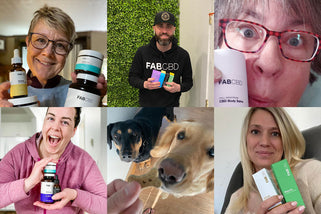We love our furry babies and want what’s best for their well-being, so when the demand for CBD (cannabidiol) products experiences explosive growth, so does the rising popularity of pet CBD oil. However, it isn’t as simple as buying an off-the-shelf CBD oil for your beloved canine.
Choosing the right type of oil for your pooch can have numerous potential benefits* but the wrong product can do more harm than good. Safety and effectiveness are key to picking the right CBD oil, as canines metabolize substances differently than humans and we have vastly different endocannabinoid systems.
In this blog post, we’ll take a closer look at CBD oil for dogs and guide you on how to use CBD for your furry friend.
Potential Benefits of CBD Oil for Dogs
CBD is gaining popularity in the pet world, with many consumers swearing by its various uses in dogs like supporting a sense of calm. While research is still in its preliminary stages, many pet owners and veterinarians report positive responses. Here are some common ways CBD may help a dog’s overall well-being*:
Pain Relief - CBD has pain-relieving and analgesic properties, making it suitable to potentially help manage chronic pain associated with post-surgery joint pain, dysplasia, and arthritis.
Anti-Inflammation - The effects of CBD can potentially reduce inflammation which could help with conditions such as gastrointestinal problems and arthritis.
Reduce Anxiety and Stress - CBD’s potential ability to promote calm and relaxation can help nervous dogs that suffer from separation anxiety or ease stressful situations like a trip to the vet.
Epilepsy - Early research indicates that CBD could potentially help with seizure management in dogs with epilepsy.
Skin Health - CBD's potential anti-inflammatory and antimicrobial properties may be helpful in managing skin conditions such as allergies, itching, or dermatitis.
Improve Cognitive Function - CBD’s neuroprotective properties could potentially help older dogs that suffer from cognitive decline or neurodegenerative conditions.
How to Choose the Best CBD Oil for Dogs
Know the Hemp Source
CBD oil comes from the hemp plant, and cultivating hemp plants that are below 0.3% THC levels are now legal in the US thanks to the 2018 Farm Bill. However, not all hemp plants are created equal, and the explosive growth of CBD has led to many jumping on the bandwagon and manufacturing CBD products.
This huge increase in production unfortunately also means that there are many inferior products out there that could potentially do your dog more harm than good.
For example, a facility that manufactures CBD together with other cannabis products could cross contaminate and you might end up with an oil that contains more than 0.3% THC, which has psychoactive effects and is toxic to dogs.
Pick top-quality products from reputable growers and look for US-grown, organic hemp made under strict quality controls. All CBD products should also have a CoA (Certificate of Analysis), which means the product has been tested by a third-party laboratory for purity and potency, so be sure to read the test results.
Be Familiar with CBD Extraction Methods
CBD extraction involves processing the hemp plant to extract a concentrated form of CBD which can then be made into oil. There are three common extraction methods: ethanol, CO2, and hydrocarbon.
Ethanol
Ethanol extraction involves soaking the hemp plant in ethanol, a type of alcohol, to dissolve the cannabinoids. The resulting liquid is then evaporated, leaving behind the concentrated CBD. It is relatively simple and cost-effective, but this process requires additional steps to ensure that the result is pure and doesn’t contain any additives.
CO2
CO2 extraction uses pressurized carbon dioxide to separate the CBD from the plant material. Carbon dioxide is passed through the material at specific temperatures and pressures, leaving behind concentrated CBD.
This is a preferred method of extract as it is efficient and precise, resulting in pure CBD extract with minimal risk of contaminants. CO2 is also environmentally friendly, non-toxic, and can be recycled in a closed system, minimizing the use of resources.
However, CO2 extraction requires equipment which can be expensive, and the process can be complex, requiring specialized skills.
Hydrocarbon
Hydrocarbons such as butane or propane are used to dissolve CBD and other cannabinoids from the hemp plant. The resulting solvent is then evaporated, leaving behind concentrated CBD.
However, like ethanol extraction, hydrocarbon extraction might leave trace amounts of butane or propane in the final product, and proper purification steps are crucial. In addition, hydrocarbons are extremely flammable and can cause significant safety risks.
Compare the Types of CBD Oil for Dogs
CBD is typically available in three distinct forms: isolate, full spectrum, and broad spectrum.
Isolate
CBD isolate is the purest form of CBD where the product contains no other cannabinoids or terpenes, simply concentrated CBD. However, this means that the product cannot promote the entourage effect.
The entourage effect is the interaction of various cannabinoids, terpenes, and other beneficial compounds working together to optimize the therapeutic effects of each component. For this reason, full spectrum CBD products that have the combined presence of all the compounds in the plant are better at harnessing the potential benefits of cannabis.
Full Spectrum
Full spectrum is when all parts of the hemp plant are harvested and used, including THC. As mentioned earlier, hemp plants are legally required to have a maximum of 0.3% THC. In this small amount, CBD products are extremely unlikely to produce a ‘high’ that marijuana products do.
Broad Spectrum
The main difference between broad spectrum and full spectrum is that during processing, THC is removed from broad spectrum CBD products while other cannabinoids, terpenes and compounds remain.
Broad spectrum CBD products might be suited for dog parents that don’t want their pooches to consume THC, but as with isolate, the lack of THC could reduce the effectiveness of the entourage effect and as such, the efficacy of the product.
Verify Certification and Testing
CBD products are not tested by the FDA (Food and Drug Administration). Instead, CBD products undergo third-party lab testing for purity and potency.
As mentioned early, each CBD product should have a Certificate of Analysis (CoA), a crucial document that provides information about potency, quality, purity, and safety of the product. It also tests for pesticide and solvent residue and heavy metal presence.
Lastly, the cannabinoid profile lists the concentration of each individual cannabinoid, the most important thing is ensuring that the THC levels remain below 0.3%. It will also show levels of other cannabinoids such as CBG and CBN.
Try Out Different Formulations
Topical creams can contain CBD if you want to administer to certain areas, for example, to reduce inflammation in the elbows.
You can also get CBD in capsules, but dogs have a tendency to prefer flavored CBD treats. If your dog isn’t responding well to one form of administration, you can switch it up and experiment to see what works best.
Determining the Right Dosage
The right amount of CBD depends on several factors like your dog’s weight, age, metabolism, and overall health, as well as the specific condition you are administering CBD for. Large dogs and younger, more active dogs might need a larger dose.
When starting your dog on CBD, start with a lower dose and then gradually increase it until the desired effects are achieved. Always consult with your vet before administering CBD, especially if your dog has a pre-existing medical condition and is currently on medication.
Side Effects and Safety Considerations
Although rare, some pet parents have reported a few mild side effects of CBD oil like dry mouth, low blood pressure, and drowsiness. To ensure your pooch’s safety, be sure to check with your veterinarian, especially if your dog has a medical condition or is currently on medication.
Monitor your dog closely for any side effects and reduce the dose or cease administering CBD. Always start with a smaller dose then gradually work your way up.
Conclusion
Sure, you want to share the potential wellness benefits of CBD with your dog, but it isn’t as simple as buying something off the shelf. You might want to consider factors like extraction methods, quality, and always buy products that have been third-party lab tested.
Before starting your dog on any regimen, be sure to check with your vet on the appropriate amount and dosage. If you’re ready to buy some CBD for your dog, check out our full-spectrum CBD oil for dogs on Fab CBD.
All our products are made of top-quality, non-GMO natural ingredients and tested extensively. If your dog prefers chews to oil, the CBD dog chew treats we have are a hot favorite!







